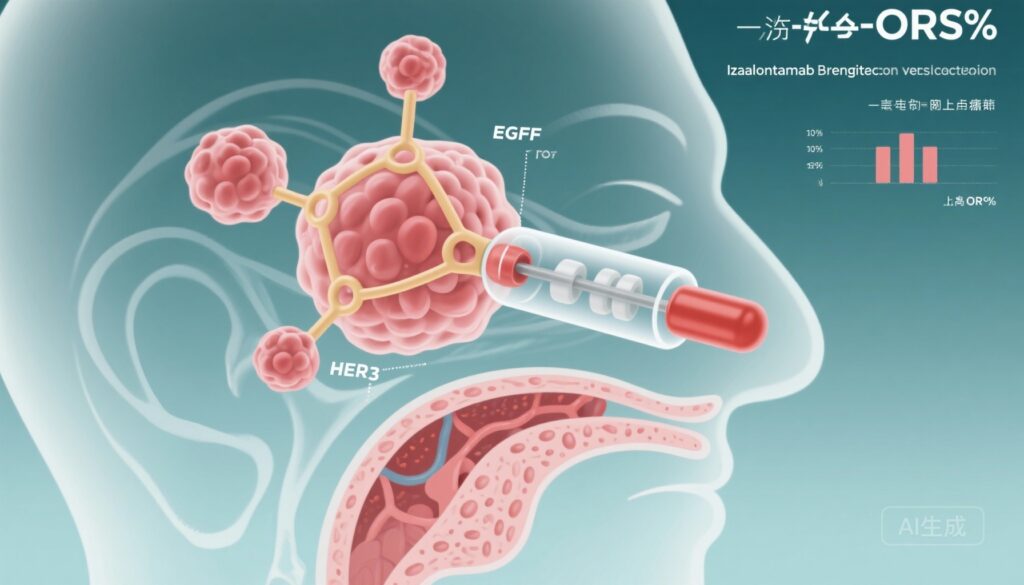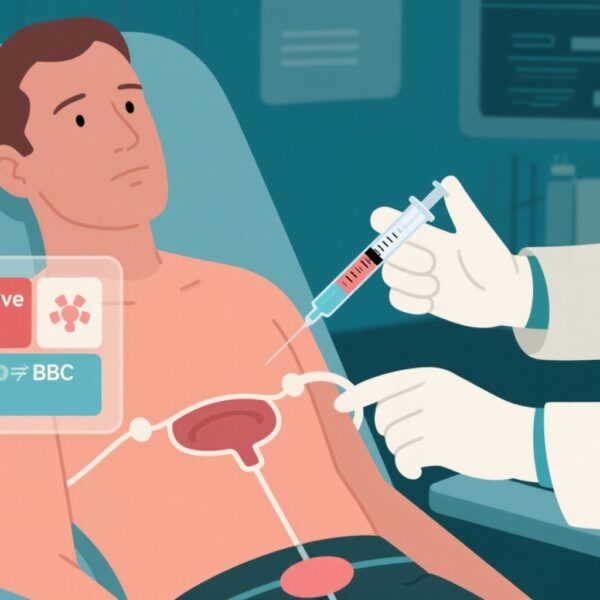Highlight
Key points
– In a multicentre, randomized phase 3 study in China (BL-B01D1–303), izalontamab brengitecan (iza-bren), an EGFR/HER3 bispecific antibody‑drug conjugate (ADC), produced an objective response rate (ORR) of 54.6% versus 27.0% with physician-choice chemotherapy in heavily pretreated recurrent or metastatic nasopharyngeal carcinoma (NPC).
– The trial enrolled 386 patients previously treated with at least two lines of systemic chemotherapy (including platinum) and PD-1/PD-L1 inhibitors; overall survival (OS) data remain immature at interim analysis.
– Grade 3 or higher treatment‑related adverse events (TRAEs) were more frequent with iza-bren (80% vs 62%), driven largely by hematologic toxicity; serious TRAEs and treatment‑related deaths were also higher with iza-bren.
Background: Unmet need in recurrent or metastatic nasopharyngeal carcinoma
Nasopharyngeal carcinoma (NPC) in endemic regions commonly presents with locally advanced disease; despite improvements in radiotherapy and chemoradiation, a subset of patients develop recurrent or metastatic disease. Options after progression on platinum‑based chemotherapy and PD‑1/PD-L1 immune checkpoint inhibitors are limited, and patient outcomes are generally poor. New targeted agents and novel drug formats such as antibody‑drug conjugates (ADCs) are being developed to deliver potent cytotoxins directly to tumor cells while exploiting tumor-selective surface antigens.
Izalontamab brengitecan is a bispecific ADC designed to bind EGFR and HER3, receptors that are frequently expressed in epithelial malignancies including NPC, and to deliver a cytotoxic payload to receptor‑expressing tumor cells. The BL-B01D1–303 trial tested whether this targeted delivery could produce clinically meaningful activity in a population that had exhausted standard systemic and immunotherapy options.
Study design
BL-B01D1–303 is a multicentre, randomized, open‑label, phase 3 study conducted at 55 hospitals across China. Key eligibility criteria included age 18–75 years, histologically or cytologically confirmed recurrent or metastatic NPC, progression after at least two lines of systemic chemotherapy (including at least one platinum‑containing regimen), and prior treatment with a PD‑1 or PD‑L1 inhibitor.
Participants were randomized 1:1 to receive either:
- Izalontamab brengitecan (iza‑bren) 2.5 mg/kg intravenously on days 1 and 8 of each 3‑week cycle; or
- Investigator‑chosen chemotherapy (physician choice; details of regimens per local standard).
Randomization was stratified by baseline Eastern Cooperative Oncology Group (ECOG) performance status (0 vs 1), presence of liver metastases, and prior lines of platinum‑based chemotherapy (one vs two or more), using an interactive web‑based response system with variable block size.
The dual primary endpoints were objective response rate (ORR) assessed by masked independent central review per RECIST v1.1 and overall survival (OS). Secondary endpoints included progression‑free survival (PFS), duration of response (DoR), and safety. This report describes the first planned interim analysis; the trial remains ongoing (ClinicalTrials.gov NCT06118333).
Key findings
Between Dec 4, 2023 and Feb 21, 2025, 522 patients were screened and 386 were randomized: 191 to iza‑bren and 195 to chemotherapy. Median follow‑up at data cutoff was 7.66 months (iza‑bren) and 7.10 months (chemotherapy).
Efficacy
ORR (masked independent central review) was substantially higher with iza‑bren: 54.6% (95% CI 45.2–63.8%) compared with 27.0% (95% CI 19.1–36.0%) with chemotherapy. The absolute difference in ORR was 27.9% (95% CI 15.5–39.4%; p<0.0001), demonstrating a robust improvement in tumor shrinkage in this heavily pretreated population.
At the interim cutoff, OS data were immature and therefore not yet reported. Secondary endpoints including PFS and DoR will be important to determine whether the higher ORR translates into prolonged disease control and survival benefit; these analyses are pending as the trial continues follow‑up.
Safety
Toxicity with iza‑bren differed qualitatively from standard chemotherapy. Grade 3 or higher TRAEs occurred in 80% of patients receiving iza‑bren versus 62% receiving chemotherapy. Hematologic toxicities were particularly prominent with iza‑bren:
- Anaemia: 50% (iza‑bren) vs 10% (chemotherapy)
- Decreased white blood cell count: 43% vs 44%
- Decreased platelet count: 43% vs 7%
- Decreased neutrophil count: 38% vs 41%
Non‑hematologic TRAEs in the iza‑bren arm were mostly grade 1–2. Serious treatment‑related adverse events were more common with iza‑bren (43% vs 27%), and there were four treatment‑related deaths (2%) in the iza‑bren group. The trial report characterizes the overall safety profile as manageable; however, the frequency of high‑grade hematologic events and serious adverse events will necessitate careful monitoring and supportive care in clinical practice.
Subgroup and operational considerations
The randomized design and masked central review of response strengthen confidence in the ORR result. Enrollment across 55 hospitals supports operational feasibility in China. The study population—patients who previously progressed after both platinum‑based chemotherapy and PD‑1/PD‑L1 inhibitors—reflects a clinically important and refractory group for whom effective options are limited.
Expert commentary and interpretation
The magnitude of the ORR improvement with iza‑bren is notable in a population with prior exposure to both cytotoxic chemotherapy and checkpoint inhibition. An ORR above 50% in later‑line NPC suggests substantial antitumor activity and may provide meaningful symptom relief and bridging to further therapies in some patients.
However, several caveats temper enthusiasm pending additional data. First, OS data are immature; improved response rates do not always translate into longer survival, particularly when subsequent therapies differ between arms. Second, the safety profile raises concern: very high rates of grade ≥3 hematologic toxicity, increased serious TRAEs, and treatment‑related deaths underscore the need for standardized management algorithms (growth factor support, transfusion guidelines, dose modifications) and careful patient selection.
Generalizability beyond the study population requires consideration. The trial was conducted entirely in China, where NPC is frequently Epstein‑Barr virus (EBV) associated and has distinct epidemiology and biology compared with nonendemic regions. Biomarker analyses—such as tumor EGFR/HER3 expression, EBV DNA kinetics, and prior response patterns to PD‑1/PD‑L1 inhibitors—will be critical to identify patient subgroups most likely to benefit and to elucidate mechanisms of response and resistance.
Finally, the study was funded by Baili‑Bio, the developer of iza‑bren. Independent confirmation and longer‑term follow‑up will be important to validate benefit and safety.
Clinical implications and next steps
If subsequent analyses confirm improvements in PFS and OS with a tolerable risk‑benefit profile, iza‑bren could become a new treatment option for patients with recurrent or metastatic NPC who have progressed after platinum chemotherapy and PD‑1/PD‑L1 inhibitors. Priorities going forward include:
- Maturation of OS and PFS data, and reporting of duration of response and quality‑of‑life outcomes.
- Detailed safety management guidance focused on prevention and treatment of severe hematologic toxicity, with prospective protocols for growth factor use and transfusion.
- Prespecified biomarker analyses to refine patient selection (EGFR/HER3 expression, EBV DNA, other genomic or immune biomarkers).
- Exploratory studies of combination strategies (e.g., ADC plus immunotherapy) or earlier‑line use in selected patients, guided by safety and efficacy data.
Limitations
Key limitations of the interim report include the open‑label design (although response assessment was centrally masked), short median follow‑up at interim analysis, immature OS data, and conduct in a single country that may affect external validity. The elevated rates of hematologic and serious adverse events emphasize that favorable response rates must be weighed against potential harms.
Conclusion
The phase 3 BL-B01D1–303 trial demonstrates that izalontamab brengitecan produces a markedly higher objective response rate than chemotherapy in heavily pretreated recurrent or metastatic nasopharyngeal carcinoma. These results indicate strong antitumor activity in a difficult-to-treat population and position iza‑bren as a promising candidate to fill a significant therapeutic gap. Careful interpretation is required given the short follow‑up, immature survival data, and substantial hematologic toxicity observed. Ongoing follow‑up, mature survival analyses, toxicity management strategies, and biomarker work will determine whether iza‑bren can be adopted as a new standard of care for these patients.
Funding and clinicaltrials.gov
Funding: Baili‑Bio (Chengdu) Pharmaceutical.
ClinicalTrials.gov identifier: NCT06118333.
References
Yang Y, Zhou H, Tang L, Qiu S, Han Y, Ji D, Chen X, Lei F, Qu S, Deng B, Chen L, Huang J, Guo Y, Liu Z, Chen D, Li J, Shu X, Qin Y, Fu Z, Li B, Zhang P, Chen S, Hong J, Wei Y, Qin X, Qu S, Yang K, Lin D, Wang J, Yang L, Xiao S, Zhu H, Zhu Y, Zhang L; BL-B01D1–303 Investigators. Izalontamab brengitecan, an EGFR and HER3 bispecific antibody-drug conjugate, versus chemotherapy in heavily pretreated recurrent or metastatic nasopharyngeal carcinoma: a multicentre, randomised, open-label, phase 3 study in China. Lancet. 2025 Nov 8;406(10516):2235-2243. doi: 10.1016/S0140-6736(25)01954-3. Epub 2025 Oct 19. PMID: 41125110.


